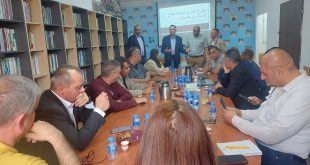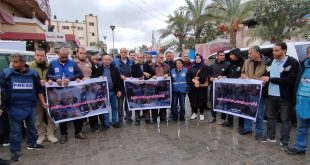Ramallah, a report issued by the Palestinian Journalists Syndicate stated that since the beginning of the aggression on the Gaza Strip on 10/7/2023, 29 journalists and 10 media workers have been killed, in addition to 18 journalists arrested in the West Bank.
The PJS statement, issued today, documents of the targeting of journalists since the start of the war on the Gaza Strip until the evening of 4.11.2023.
Killed journalists:
-
Ahmed Shehab, program producer on Voice of Prisoners Radio
-
Photojournalist Muhammad Al-Salhi, photographer of the “Fourth authority” agency.
-
Freelance photojournalist Muhammad Fayez Abu Matar
-
Journalist Hisham Al-Nawajha, photographer for “Khabar” agency
-
Photojournalist Ibrahim Lafi from Ain Media Foundation.
-
Journalist Saeed Al-Taweel, editor-in-chief of the Fifth News Agency
-
Journalist Muhammad Jarghoun from Smart Media Agency.
-
Freelance journalist Asaad Shamlakh
-
Journalist Muhammad Abu Rizq, Khabar Agency photographer.
-
Freelance journalist Salam Mema.
-
Journalist Hossam Mubarak, broadcaster on Al-Aqsa Channel
-
Journalist Issam Bhar, Al Aqsa Satellite channel
-
Journalist Abdul Hadi Habib, AL Manaea news agency and HQ media
-
Journalist Mohammad Balousha, Palestine today TV channel.
-
Photojournalist Khalil Abu Athra, Al Aqsa Satellite Channel
-
Journalist Muhammad Abu Ali, Al-Shabab Radi
-
Photojournalist Rushdi Al-Sarraj, Ain Media
-
Journalist Muhammad Imad Labad, Al-Resala newspaper
-
Journalist Saed Al-Halabi, Al-Aqsa Satellite Channel
-
Journalist Ahmed Abu Mahdi, Al-Aqsa Satellite Channel
-
Freelancer journalist Salma Mekheimer
-
Journalist Jamal Al-Faqawi, New Scene TV and Documentary Production Company
-
Journalist Doaa Sharaf, presenter of programs on Sawt Al-Aqsa Radio
-
Freelancer Journalist Yasser Abu Namous
-
Journalist Majd Fadel Arandas, Al Jamahir news website
-
Journalist Mohammad Bayari, Aqsa Satellite channel
-
Journalist Mohammad Abu Hatab, Palestine TV correspondent
-
Journalist Haitham Harara, Government Media office
Killed media workers:
- Rajab Al-Nakib
- Abdul Rahman Shehab
- Mahmoud Abu Zarifa
- Iman Okeili
- Ahmed Masoud
- Muhammad Al-Husseini
- Nazmi El-Nadim
- Imad Al-Wahidi
- Majid Kishko
- Iyad Matar
Missing Journalists:
- Photojournalist Nidal Al-Wahidi, who works as a producer with Al-Najah TV.
- Journalist Haitham Abdel Wahed from Ain Media Foundation
Interruption of Communication and news:
On the evening of Friday, October 27th 2023, all means of communications were cutoff in Gaza Strip as a result of the Israeli occupation forces’ bombing of communications towers which interrupted all possibilities for communication in and with Gaza. The communications cutoff continued for more than 24 hours, and efforts were made at all levels and in coordination with all relevant parties to restore communications in Gaza.
The interruption of communications, then its irregular and difficult restauration, had a major impact in hindering the PJS ability to document and obtain accurate data, as the documentation teams were no longer able to reach all journalists and know about the crimes they were exposed to with accurate statistics and details. This has confirmed the Israeli occupation forces’ approach of committing crimes in Gaza, without any media coverage, so as not to reveal its brutal side and explicit goal of ethnic cleansing against defenceless civilians in Gaza.
In addition to killing, Journalists in Gaza suffer from injury, loss of housing and families, and forced displacement:
In light of the inability of any working body to document accurate numbers about the crimes committed by the Israeli occupation in Gaza, the PJS confirms that Palestinian journalists suffer what other civilians in Gaza Strip suffers. Hence the PJS estimates that there are hundreds of journalists who suffer from injuries of varying degrees and the loss of their homes and family members, in addition to a catastrophic forced displacement, which means starvation, and lack adequate residence and nonaccess to the basic necessities of life.
Destroying media offices and preventing them from broadcasting:
More than 50 offices and centers of media institutions were destroyed as a result of the bombing, including foreign and Palestinian agencies, the latest of which was Al-Hana Media Production Company. Moreover, the twenty-four radio stations in the Gaza Strip were also disrupted and stopped broadcasting due to the depletion of energy sources or bombing, in addition to the closure of some media institutions in the West Bank such as G Media and Dream. Some media networks were subjected to cyber-attack and interruption, such as the Raya network and Al Rabe’a Radio, in addition to the prevention of broadcast of Al-Aqsa Channel from the Eutelsat satellite in response to the pressures of the Israeli occupation. Additionally, on 3.11.2023 the Israeli Occupation air strikes bombed the centers and offices of a number of media institutions in Al-Ghafry Tower in Gaza, which includes the French Press Agency (AFP), Al-Jazeera Channel, Al-Sharq Channel, and the Palestinian Media Group Foundation, which provides services to many satellite channels.
Violations and arrests in the West Bank and Jerusalem:
The PJS has also documented dozens of cases of detention, preventing media crews from working, cases of physical assault, confiscating and destroying of journalists’ equipment, in addition to the escalation of the dangerous incitement practiced against Palestinian journalists by various Israeli parties.
Journalists in the West Bank also witnessed a massive arrest campaign that included 18 journalists, bringing the number of journalists in Israeli occupation prisons to more than 30.
List of journalists who have been arrested since October 7:
- Journalist Muhammad Nimr Asida from Nablus,
- Journalist Sabri Jibril – Bethlehem
- Journalist Mustafa Al-Khawaja – Ramallah
- Journalist Abdel Nasser Al-Laham – Ramallah
- Wounded journalist Moaz Amarneh – Bethlehem
- Journalist Alaa Al-Rimawi from Ramallah
- Journalist Imad Abu Awad from Ramallah
- Journalist Osama Shaheen from Hebron
- Journalist Alaa Al-Rubaie from Ramallah
- Thaer Fakhouri from Hebron
- Musab Qafisha from Hebron
- Journalist Radwan Qatnani from Nablus
- Bilal Arman from Ramallah
- Ramez Al-Najjar from Bethlehem
- Muhammad Badr from Ramallah
- Nawaf Al-Amer
- Zakaria Abu Fanar from Hebron
- Louay Amr from Hebron
How do journalists live during war?
Through the PJS communication with journalists in Gaza, some details were gathered about the lives of journalists during the war. Most journalists reside in hospitals that provide electricity and the Internet, which is at risk of running out due to the exhaustion of fuel in hospitals which are full of injured and displaced civilians. Journalists sleep and spend their days there within very scarce means, As many of them do not find a mattress or covers to sleep on, and some of them sleep inside their cars. Food is scarce, drinking water is completely not found, while the most difficult is that many journalists suffer from a difficult psychological condition, yet they insist on continuing despite the suffering, the pain of loss, the difficulty of communicating with the rest of their families.
Support and solidarity activities:
In light of the tragic situation that Palestinian journalists are experiencing and the PJS maintaining its communication with sister unions and institutions through updated statements and reports, popular and international solidarity to the PJS has continued to increase daily until the date of this update through many messages and statements of support and solidarity activities that received widespread popular participation to support Palestinian journalists. The most prominent of which were from the journalists’ unions in Egypt, Britain, Tunisia, Syria, Lebanon, Jordan, Oman, Sri Lanka, Yemen, Morocco, Uganda, Guinea Basso, Greece, Canada, South Africa, the United States, Spain, Belgium, Japan, Australia, the Federation of Latin American and Caribbean Journalists, and the Federation of African Journalists. Which had a great impact in supporting journalists and spreading hope in their souls in these difficult circumstances.
In the context of these dangerous developments, the PJS warns of the humanitarian catastrophe facing all life aspects in Gaza Strip and urges all international, popular and journalistic bodies to intervene immediately and stop the war of ethnic cleansing taking place in Gaza.
General Secretariat
Palestinian Journalists Syndicate
 نقابة الصحفيين الموقع الرسمي لنقابة الصحفيين
نقابة الصحفيين الموقع الرسمي لنقابة الصحفيين



